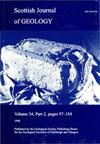元古代河流的物理和生物功能:来自苏格兰西北部Torridon群原型前植被冲积层的证据
IF 1.3
4区 地球科学
Q4 GEOLOGY
引用次数: 8
摘要
在现代河流中,植被影响着水文、地貌和沉积功能,因此现存的河流系统只能提供部分类似于那些在陆地植物进化之前运作的河流。然而,在地球前90%的历史中,没有植被的河流是常态,因此,更好地了解它们的沉积产物,可以帮助我们了解河流行为的基本潜在机制,以及河流过程在古代地球上的运作方式。除了对前植被冲积的研究历史进行简要回顾外,本文还介绍了元古代晚期Torridon群的实地研究案例,其中包含了世界上最广泛和最容易获得的前植被冲积暴露。已识别出3种冲积构造矿床:(1)河道-河床型矿床(约占80%);(2) barform矿床(约20%);(3)通道外沉积物(≪1%)。河道-河床沉积具有侵蚀基底,通常垂直堆积形成厚的多层河道-河床层序。这些沉积记录了河道最深处,具有优先保存的特点,表明河道迁移对Torridon群的保存起主导作用。不太常见的是,河道-河床型沉积向上过渡为与遗传有关的形状沉积。在这些情况下,Barform保存被解释为由于通道撕裂,这保护了Barform免于再加工。从河道床状沉积物的基底侵蚀面到与其相关联的条形沉积物顶部测量的河道坝厚表明,最小水深为1.7 ~ 8.0 m。最常见的是下游的滩状沉积,但也有侧向和上游的滩状沉积。东南-古流动方向的优势暗示了托里多尼亚河来源于格伦维利安山带。通过将Torridon群解释为以低曲度河流为主的冲积层,并记录了自生河流调整的特征,解释了保存下来的建筑沉积和古水流数据的狭窄分布。在少数保存下来的河道外沉积物中,它们含有微生物席的化石证据,证明并非所有的元古代河流系统都是完全非生物的。Torridon冲积层的总体特征,就其普遍存在的沙级或较粗物质的高度板状床而言,使其成为全球已知的前植被冲积层的典型例子。专题合集:本文是SJG早期职业研究合集的一部分,可在https://www.lyellcollection.org/cc/SJG-early-career-research上找到本文章由计算机程序翻译,如有差异,请以英文原文为准。
Physical and biological functioning in Proterozoic rivers: evidence from the archetypal pre-vegetation alluvium of the Torridon Group, NW Scotland
In modern rivers, vegetation affects hydrological, geomorphological and sedimentological functioning, so extant fluvial systems can provide only partial analogues for those rivers that operated before the evolution of land plants. However, pre-vegetation rivers were the norm for the first 90% of Earth's history and so a better understanding of their sedimentary product can provide insights into both the fundamental underlying mechanisms of river behaviour and the ways in which fluvial processes operated on ancient Earth. In addition to a short review of the history of research into pre-vegetation alluvium, this paper presents a fieldwork-based case study of the later Proterozoic Torridon Group, which contains some of the most extensive and easily accessible exposures of pre-vegetation alluvium worldwide. Three alluvial architectural deposits have been recognized: (1) channel-bedform deposits (c. 80%); (2) barform deposits (c. 20%); and (3) out-of-channel deposits (≪1%). Channel-bedform deposits have erosional bases and most frequently stack vertically to form thick multistorey channel-bedform sequences. The preferential preservation of these deposits, which record the deepest parts of river channels, suggests that channel migration had a dominant control on preservation in the Torridon Group. Less frequently, channel-bedform deposits pass upwards into a genetically related barform deposit. Barform preservation in these instances is interpreted to be due to channel avulsion, which protected the barforms from reworking. Channel-bar thickness, measured from the basal erosional surface of a channel-bedform deposit to the top of its associated barform deposit, indicates minimum water depths of 1.7 to 8.0 m. Downstream-accreting barform deposits are most frequent, but lateral and upstream modes of accretion are also well represented. Dominant southeastward-palaeoflow directions imply that the Torridonian rivers were sourced from the Grenvillian Mountain Belt. The preserved architectural deposits and narrow dispersal of palaeocurrent data are explained by interpreting the Torridon Group as the alluvium of dominantly low-sinuosity rivers, with signatures recording autogenic fluvial adjustments. In the few rare instances where out-of-channel deposits are preserved, they contain fossil evidence for microbial mats, which prove that not all Proterozoic river systems were wholly abiotic. The overall characteristics of the Torridon alluvium, in terms of its ubiquitous highly tabular beds of sand-grade or coarser material, make it an archetypal example of pre-vegetation alluvium as known globally. Thematic collection: This article is part of the SJG Collection on Early-Career Research available at: https://www.lyellcollection.org/cc/SJG-early-career-research
求助全文
通过发布文献求助,成功后即可免费获取论文全文。
去求助
来源期刊

Scottish Journal of Geology
地学-地质学
CiteScore
1.70
自引率
0.00%
发文量
10
审稿时长
>12 weeks
期刊介绍:
Although published only since 1965, the Scottish Journal of Geology has a long pedigree. It is the joint publication of the Geological Society of Glasgow and the Edinburgh Geological Society, which prior to 1965 published separate Transactions: from 1860 in the case of Glasgow and 1863 for Edinburgh.
Traditionally, the Journal has acted as the focus for papers on all aspects of Scottish geology and its contiguous areas, including the surrounding seas. The publication policy has always been outward looking, with the Editors encouraging review papers and papers on broader aspects of the Earth sciences that cannot be discussed solely in terms of Scottish geology.
The diverse geology of Scotland continues to provide an important natural laboratory for the study of earth sciences; many seminal studies in geology have been carried out on Scottish rocks, and over the years the results of much of this work had been published in the Journal and its predecessors.
The Journal fully deserves its high reputation worldwide and intends to maintain its status in the front rank of publications in the Earth sciences.
 求助内容:
求助内容: 应助结果提醒方式:
应助结果提醒方式:


